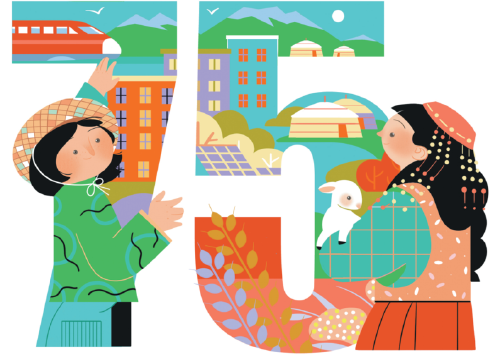As they mark the 75th anniversary since establishing diplomatic relations, Mongolia and China have many other historic dates to celebrate their strategic collaboration
By BATSUKH GALSAN

Today, Mongolia and China enjoy a comprehensive strategic partnership. Collaboration is prospering equally in all sectors and as further commitment to this cause, both countries have agreed to strive toward setting an exemplary model of 21st century inter-state relations.
During the state visit of Mongolian President Ukhnaa Khurelsukh to China in November 2022, both heads of state issued a joint statement on advancing bilateral comprehensive strategic partnership in the new era.
The declaration arose out of the need to finetune the existing bilateral relations by reflecting on post-pandemic realities. The bilateral document also linked national development policy mechanisms. Against this backdrop, both parties announced their commitment to better integrate development plans, including Mongolia's Steppe Road vision with China's Belt and Road Initiative, Mongolia's New Revival Policy with China's Global Development Initiative, and Mongolia's long-term development vision until 2050 with China's two-step development strategy. This joint declaration serves as the road map for bilateral relations and for further enhancement of the neighboring partnership.
One is rather compelled to think that such political drive and zealousness serve as a signpost for bilateral relations and at the same time foster conditions favorable to strengthen the two countries' partnership in all fields of cooperation. For this reason, this period is the most favorable time in the history of Mongolia-China relations.
The high-level political exchanges between the two sides have been conducive to lifting the bilateral trade and economic relations, which are the cornerstones of their long-term strategic partnership. The volume of bilateral trade has been rapidly expanding since 2014, rising to $10.1 billion in 2022. This is the direct results of the Outline for Midterm Development of China-Mongolia Trade and Economic Cooperation.
The program has played an important role in bilateral trade, investment and development cooperation, and will serve as a principal framework for further expanding the relationship in this area in the years to come. It will focus on cooperation in mining, energy, finance, transportation, tourism and agriculture, and improve the quality and level of investment.
It should be noted that Mongolia is well positioned to greatly benefit from the BRI, which was launched a decade ago, and Mongolia has enthusiastically supported and actively participated in it since its inception. Ten years appear to be a short span in the lengthy history of Mongolia-China relations, but it is a hallmark period leaving a distinct and lasting mark. This brings to mind China's strategy for South-South cooperation and development through the initiative's focus on facilitating trade with neighboring countries and enabling a smooth regional supply chain.
Under the framework of the FAO-China South-South Cooperation Programme, Mongolia was the first recipient of the project implemented in Asia. This program has provided critical support aimed at improving agricultural production, food safety and nutrition in the country. The numerous benefits, reaped by the participants and stakeholders, represent the building blocks of stronger agri-food systems in Mongolia.
This kind of trilateral cooperation will greatly help to further enhance Mongolia-China economic collaboration.
At the start of 2024, Mongolia has launched a new project to strengthen forest firefighting capacity toward green recovery with support from the Global Development and South-South Cooperation Fund. At the launch of this project, Shen Minjuan, China's ambassador to Mongolia, said that this project can support Mongolia's forest conservation efforts and promote green development. China will take a more active part in multilateral development cooperation through the Global Development and South-South Cooperation Fund to build a community with a shared future for global development.
Another potential area of cooperation is the environment, in particular, combating desertification in the trans-boundary zones. The establishment of the China-Mongolia Desertification Prevention and Control Cooperation Center in 2023 is a promising start and platform for joint actions in this area.
At the third Belt and Road Forum for International Cooperation, Mongolian President Khurelsukh said that by closely coordinating eco-friendly economic and social development and deepening renewable energy cooperation, the two countries can help build the Green Silk Road together and advance the harmonious existence of people and nature.
Therefore, jointly establishing ecological green zones such as forest walls, human-made oases and wildlife sanctuaries to curb the process of accelerating desertification in the trans-boundary areas can lead Mongolia and China to a new model of strategic collaboration.
People's diplomacy, cultural, educational and professional exchanges are on the path of intensification in the post-pandemic era. In this respect, the Mongolia-China Friendship Association plays a leading role in refreshing the decades-old tradition of celebrating the Mongolia-China Friendship Week in Mongolia and promoting direct cultural relationship between the cities and provinces of the two countries.
This year marks the 75th anniversary of the establishment of diplomatic relations between Mongolia and China and the 10th anniversary of the establishment of a comprehensive strategic partnership between the two countries. These dates are celebrated as milestones for establishing a new model of friendship and partnership which serves the mutual interests of the two nations.

The author is former ambassador of Mongolia to China and chairman of Mongolia-China Friendship Association. The author contributed this article to China Watch, a think tank powered by China Daily.
Contact the editor at editor@chinawatch.cn.
来源:chinadaily
编辑:樊令钰
 时刻新闻
时刻新闻